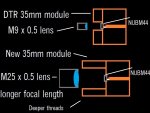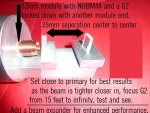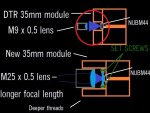I'm all about sharing what I know and learning from others, and if someone has a better way then by all means show me, I will be happy to do it their better way as long as I don't have to spend 10X the money for a 5% increase in performance.
Sadly cost is a factor and I suspect many people are content with the ready made lens and ready made expander that works pretty well.
But for those of us wanting more and looking to the future I am all about sharing what little I have learned and I want very much to share in the fruits of their labors and I will give praise and recognition in place of financial contributions that I cant afford.
People who are sharing their knowledge that they spent time and money to acquire do deserve at the least some praise and recognition, as well as some respect, you said something before, you said babble away and I will learn, well if you are polite and accept a little protocol correction in a new place, lets take this place, it's not really a free public place where free speech rights prevail.
No it's privately owned and if we as guests don't follow the rules then we can be ejected, so if the know it all at the apple store has some knowledge and by kissing a tiny bit of his backside you can gain some knowledge, then you can work ahead with that new knowledge while he sits around talking, then you can give away what he knew and more without requiring a lick on your boot.
But that's an extreme example, most people here are helpful and mostly worry about safety, liability, and a modest amount of courtesy is expected or they won't bother to get up and help you, but you already have learned the secret, it's all here in text, just start searching and reading and you can figure most of it out, although I still don't know how to calculate lenses even though I am very good at math, I really should, it will be needed to bypass the idiot proof GBall of tomorrow.
With the right lens we simply reverse engineer.....I just had a thought, what if I pulled the can off a GBall diode ( 1 of 2 of the same diodes, same lens order ) and cut the can down, then simply turned the lens around and mount them face to face?
Could I not get a point equal the distance of the emitter to the intact GBall with a emitter size point to correct and run with?
It just means sacrificing 1 to use another out of the same block.
Bring on the next gen I have a plan.














